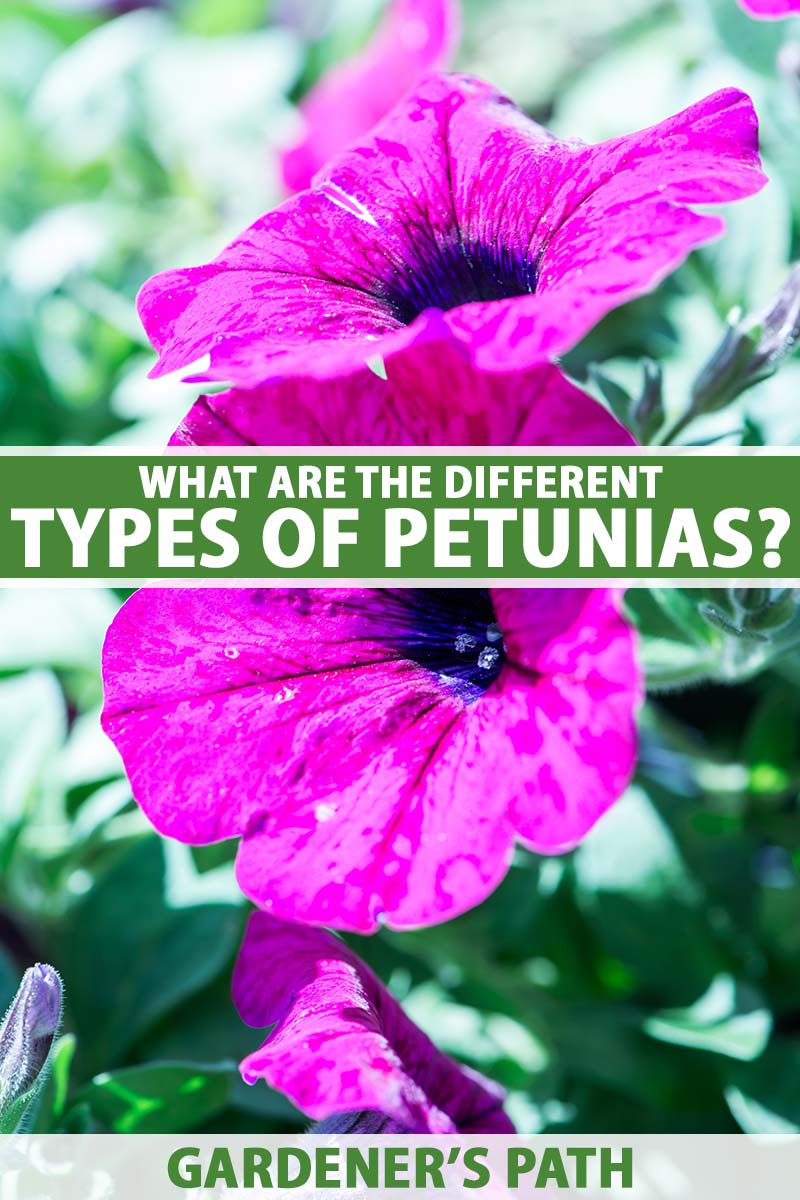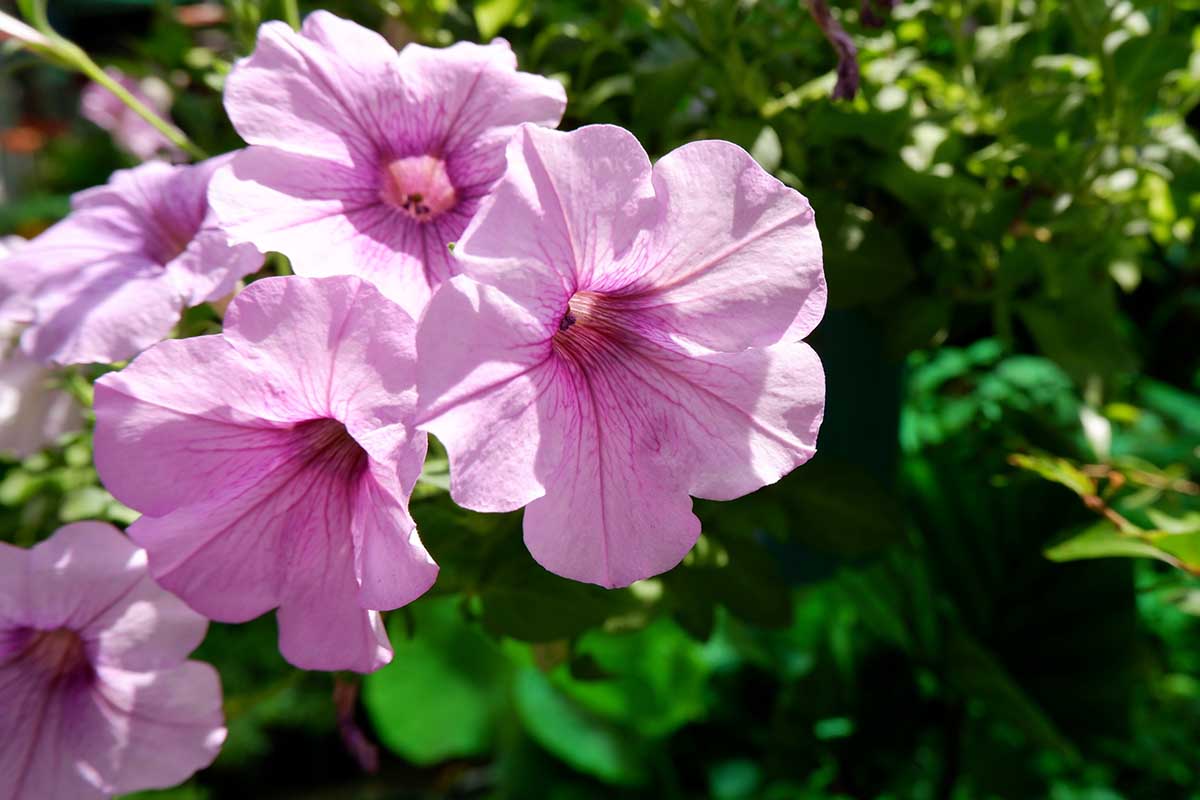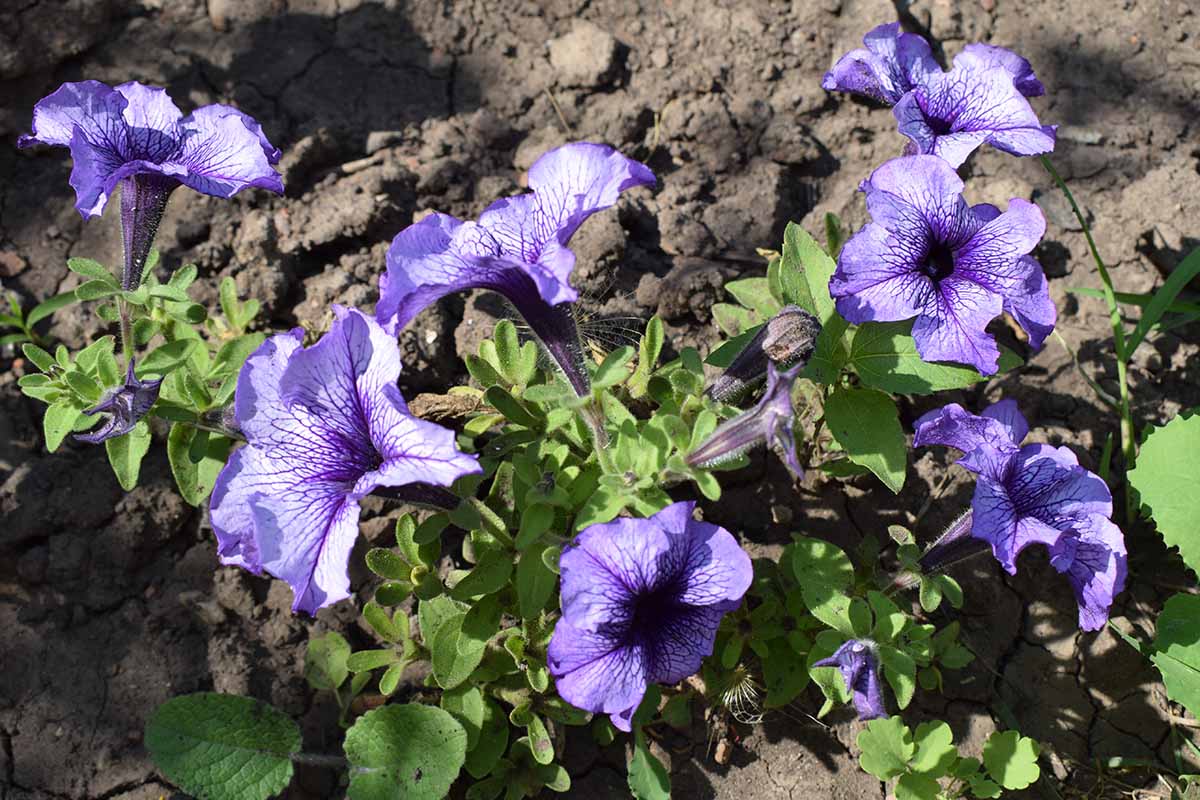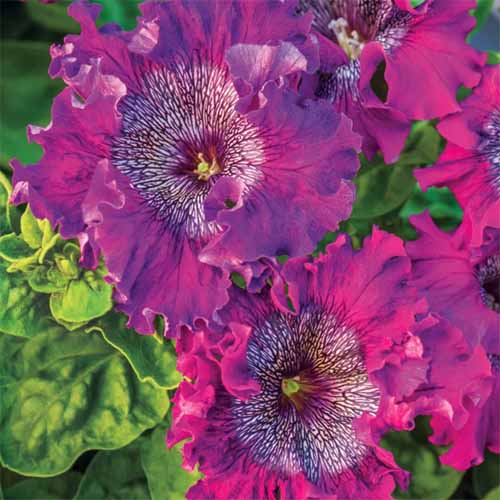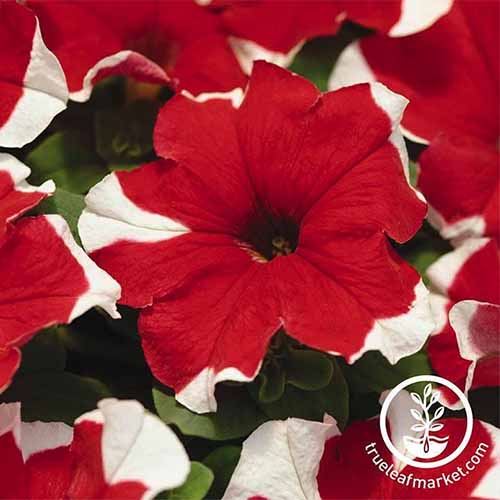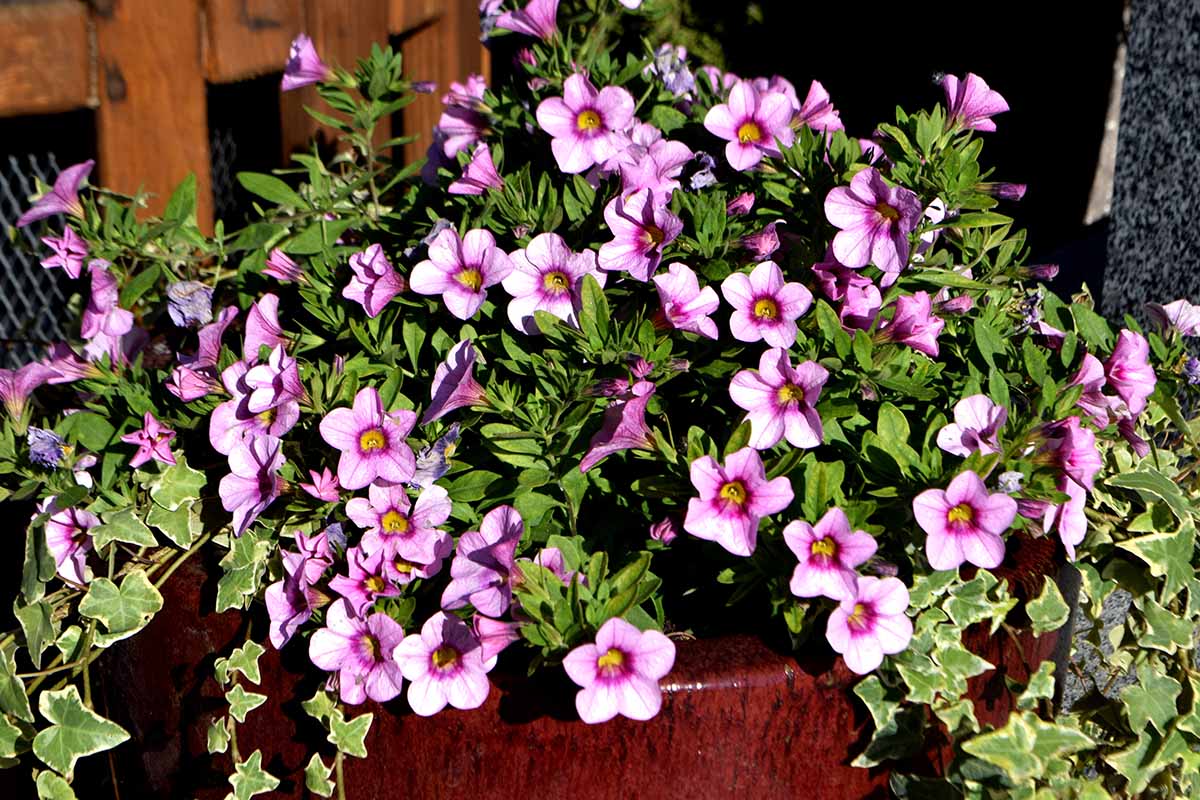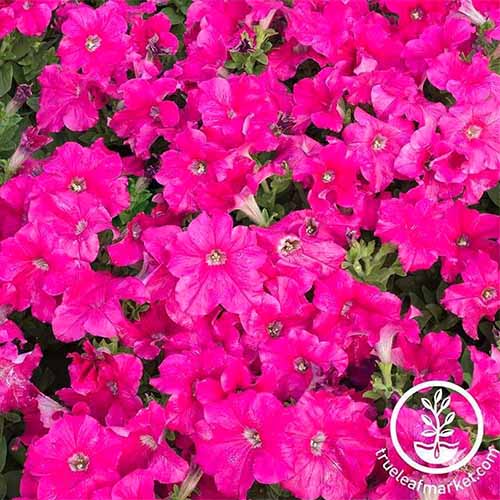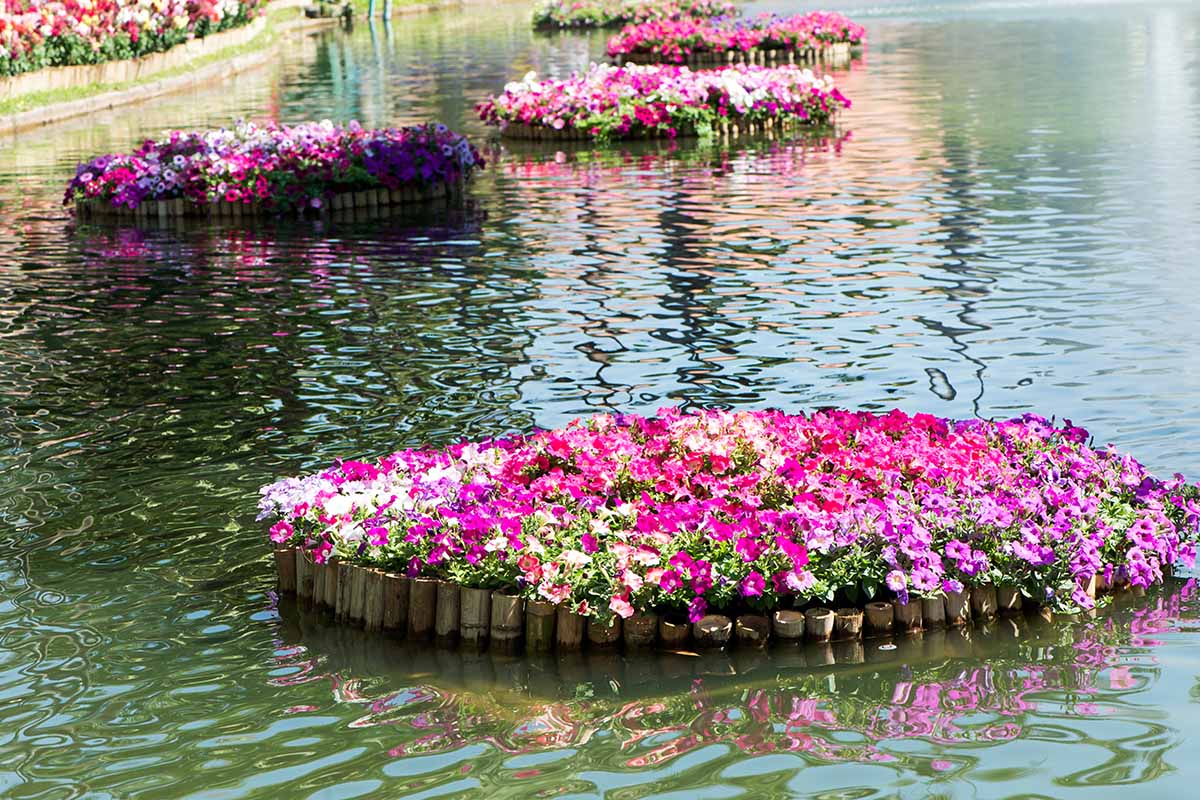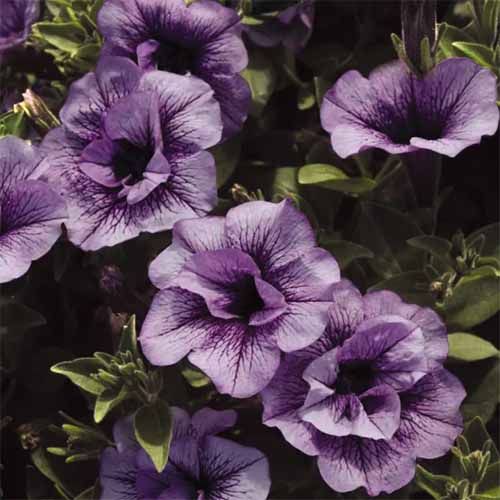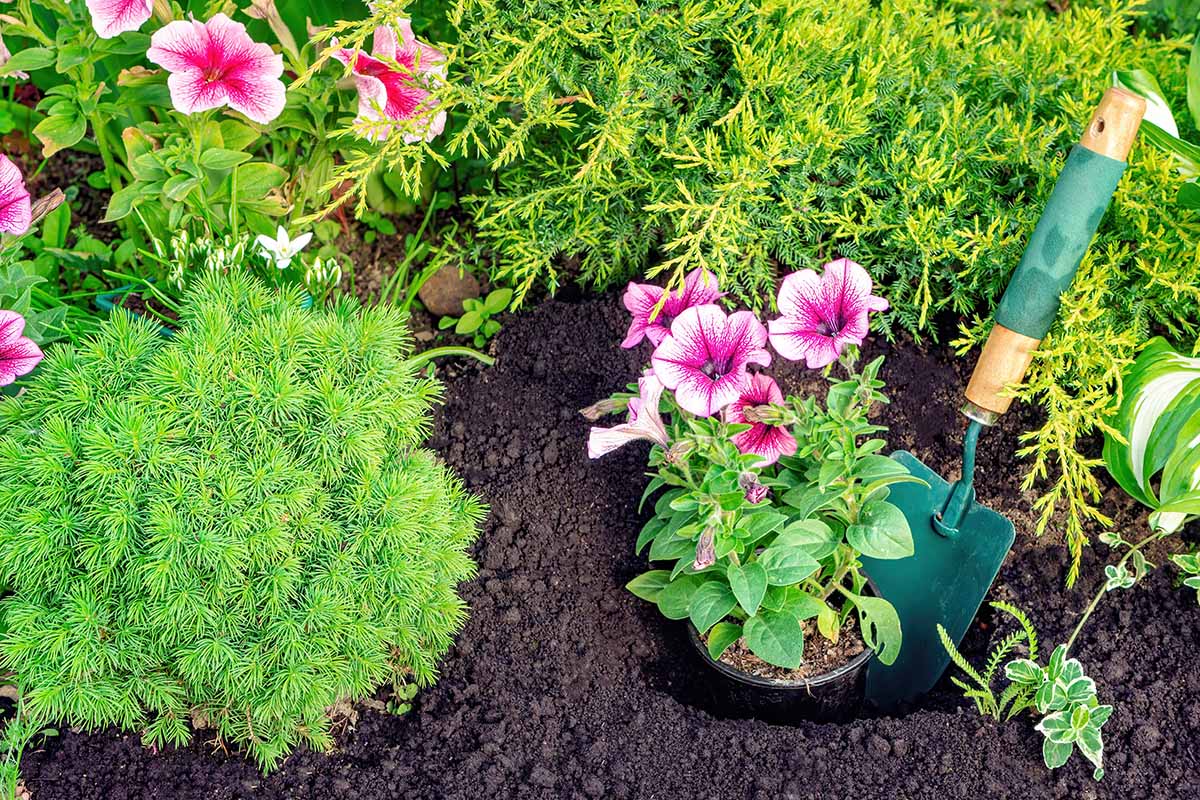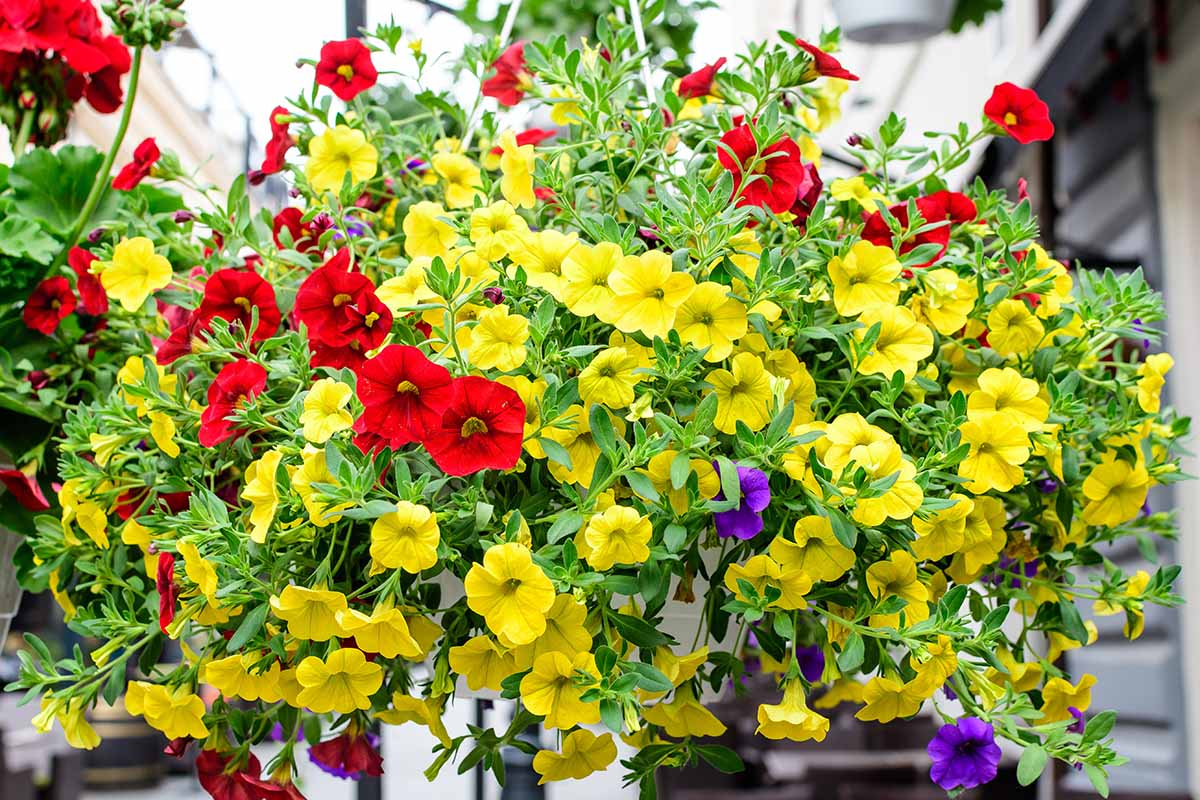The Petunia genus includes a dazzling array of bloom colors, like pink, red, purple, and white, as well as bicolors, picotees, and blooms that look like the night sky, speckled with stars. We link to vendors to help you find relevant products. If you buy from one of our links, we may earn a commission. Categories have been developed to distinguish one from the next based on growth habit and characteristics of the flowers. Certain types of petunia feature extra-large double blooms, for example, or a spreading habit that will cover bald spots in the landscape. And these popular ornamentals can anchor or complement many different garden and landscape styles, depending on which type you choose. All of them are long-blooming and relatively easy to grow and care for, so it’s okay to just buy the first bedding plants you see if you wish, or grow the same cultivar you like to start indoors from seed every winter. But you owe it to yourself to discover the advantageous traits within different petunia groups, in terms of their flower characteristics and the expected growth habit for each type. You may have been missing out on a variety that would work particularly well in an overlooked part of the garden or landscape, or one that could grace a container or hanging basket in style. Allow us to introduce five unique categories of petunias. Each type has distinct merits and all of them are standouts in the proper growing environment. Here’s the lineup:
Understanding the Five Types of Petunia Plants
Native to South America, petunias have trumpet-shaped blooms in a riot of different colors. There are 35 known species, and the ones most commonly grown in home gardens are all hybrids. They’re only winter-hardy in Zones 9 to 11, so most North American gardeners grow petunias as annuals. All varieties have these traits in common:
They bloom over a long period of timeThey have colorful trumpet-shaped flowersThey attract pollinating insects and hummingbirds
Beyond that, there’s a bit of variety within the genus, and plant breeders continue to expand on this, developing new and exciting cultivars that feature bold and beautiful blooms, a dwarf habit, disease resistance, and other features. The five categories described below are organized according to each type’s growth habit and the size of its flowers. Additional types are also noted within a few of these broader groupings. It’s important to remember, however, that we’re dealing with hybrids, and these types are not organized according to the usual tenets of botanical taxonomy. Some overlap exists, and you may find a certain series of petunia cultivars described within two different groupings, or a different group altogether, when you conduct your search for plants at the nursery. You may also come across specific series or cultivars that feature a different growth habit or stature than what is typically expected – plants with a compact growth habit and large or particularly abundant flowers, for example. Here, we’ll cover the basics in order from largest to smallest flower size, and note some recommended options for each that you might like to grow at home.
1. Grandiflora
Love big, splashy blooms in vibrant colors? Grandifloras don’t typically produce as many flowers as the other types, but they make up for this in size. They’re big and showy, between three and five inches across. These usually have an upright, mounded form, typically growing 15 to 24 inches tall and spreading up to 36 inches. Cascading grandiflora varieties are available too, including those in the Cascade or Super Cascade series as well as the Diamond series, and the Explorer series which doubles as a ground cover. You may see grandifloras and others with long, flexible, trailing stems referred to as pendula-type petunias. You’ll find some dwarf grandiflora cultivars as well, like those in the Limbo series, which grow to just four to eight inches tall, without becoming leggy. Or consider the Flash Sweetunia series if you’re looking for something more compact that also produces more blooms than your typical grandiflora. One of the earliest hybrid types developed, dating back to the 1950s, grandiflora blooms can be double or single. Some are ruffled or fringed, like ‘Fluffy Ruffles’ or those in the Daddy series. These are also referred to as fimbriata types. There is a tradeoff for those bodacious blooms, though – with the exception of a few recent hybrids, like those in the Storm series, grandifloras don’t stand up well to hard rain, and the plants are susceptible to rot during periods of heat and humidity. Southern gardeners, beware! Also, grandifloras absolutely require deadheading to maintain their good looks. Note that you will typically find cultivars in a range of colors within a recommended series, as well as mixed options, when purchasing seeds or starts.
2. Multiflora
Multifloras produce plenty of flowers but they’re smaller than grandifloras – about two inches wide – on more compact plants. Recommended Series: Aladdin, Amore, Aphrodite, Avalanche, Cascade, Cascadias, Constellation, Daddy, Diamond, Dreams, EZ Rider, Explorer, Falcon, Famous Laser, Fanfare, Flash Sweetunia, Frost, Go!Tunia, Limbo, Hulahoop, Magic, Mistral, Pacta Parade, Sophistica, Storm, Success! 360°, Super Cascade, Supermagic, Surfinia, TriTunia, Trumpet, Ultra, Viva Top Pick for Your Garden: Spellbound ’Dark Purple’ has frilly blooms with painterly, veined white centers that seem to spiral before your eyes. And they’re lavish, at four to six inches wide Spellbound ‘Dark Purple’ Spellbound ‘Dark Purple’ is available in four-plant bundles and packets of 15 seeds from Burpee. Petunias of this type, with a cascading habit and frilly, corrugated petals, also belong to the superbissima group. These usually grow about 10 to 12 inches tall, and spread 10 to 15 inches. They may require some pruning if they start to become leggy. Plants in the Mambo series are good picks if you’re looking for a dwarf option. A welcome advantage to choosing this type is that these flowers are often self-cleaning. If this is true for the variety you pick, the spent blooms will drop without deadheading, which makes them the optimal choice for large plantings. They also hold up better in rainy weather than grandifloras. Another type with a long history dating back to the 1950s, multifloras can have single or double blooms. These cultivars are known for presenting the widest range of colors, and the plants grow a bit more quickly than grandifloras. First, determine if your choice falls into a group that requires deadheading. Grandifloras and floribundas usually need their spent flowers to be removed to look tidy and keep blooming. Recommended Series: Carpet, Dot Star, Easy Wave, Espresso, Good and Plenty, Hurrah, Mambo, Mirage, Pearls, Primetime, Tidal Wave Top Pick for the Garden: A mixed collection of unnamed multiflora petunias that bloom in shades of coral, light purple, and pink, with a veined pattern on the petals. Multiflora
3. Floribunda
Floribunda plants are often grouped with the multifloras, and some – like those in the Wave series – are also considered spreading varieties. Hybrids of grandiflora and multiflora-type plants, these exhibit the best qualities of both, with lots of large blooms, tolerance for rainy weather, and increased disease resistance. They grow about eight to 15 inches tall, and spread 10 to 12 inches, though some plants are more compact. These types are not typically self-cleaning, and they will usually require some deadheading or pruning. Best Uses: Borders, containers, garden beds Recommended Series: Celebrity, Double Madness, Double Wave, Freedom, Frillytunia, Horizon, Pretty Flora, Prism, Madness, Merlin, Wave Top Pick for the Garden: Madness ‘Red Picotee’ features three-inch blooms in vibrant red, edged in white. Madness ‘Red Picotee’ Pelleted seeds in packages of 1,000 are available from True Leaf Market.
4. Milliflora
One of the more recent introductions, these miniature petunias have smaller, single blooms, usually just one to one and a half inches in diameter. But what you lose in size, you gain in number. Milliflora plants will spend most of the season covered in flowers. These are also good for small-space gardens, and most milliflora types are self-cleaning, so they won’t require deadheading. The dwarf plants are more compact than other varieties, with a mounding habit. They grow just eight inches tall and wide on average. You can space millifloras just four to six inches apart, versus 12 inches for multifloras or three feet for spreading ground cover varieties. Don’t confuse Calibrachoa (Million Bells) for these – though they share the same growth habits and care requirements, these are not actually petunias. Adding to the confusion, Petunia x calibrachoa hybrids also exist, like the “Petchoa” SuperCal series of plants. Best Uses: Containers, edging flower beds Recommended Series: Fantasy, FlashForward, Picobella, Shock Wave, Tiny Tunia, Vivini Top Pick for the Garden: Picobella ‘Carmine’ truly puts on a show, producing tons of tiny hot pink blooms that will look gorgeous spilling over the edge of a patio planter or hanging basket. Picobella ‘Carmine’ Pelleted seeds are available in packs of 1,000 from True Leaf Market.
5. Trailing or Ground Cover
This group of series and cultivars grow vigorously and spread enthusiastically, covering 10 square feet of garden beds or borders per plant in a single season, and typically reaching only about four to six inches in height. With some varieties also referred to as spreading or hedgiflora-type plants, they’re particularly heat and drought tolerant, and don’t usually require deadheading to look good. Tidal Wave is known as a hedgiflora type, for example, thanks to its ability to produce a thick and lush ground cover. Several different Wave series plants are often included in this category, though they technically fit within other groupings, as mentioned above. With a creeping growth habit, these are also standouts grown in hanging baskets, where the vines trail over the sides instead of along the ground. And if you’re designing your own blooming containers for the summer patio or a balcony garden, remember that trailing petunias can be both the “filler” and the “spiller” in a combination. Best Uses: Hanging baskets, pedestal pots, ground cover; mass plantings in borders, along paths, or in hard-to-reach spots in the landscape Recommended Series: Blanket, Double Blanket, Hang Out, Supertunia, Tidal Wave, Velvet Top Pick for the Garden: Supertunia ‘Priscilla’ has light purple double blooms with deep purple veins. Like other ground covers, this cultivar grows quickly, with a mounding or trailing habit. Supertunia ‘Priscilla’ Supertunia ‘Priscilla’ is available from Proven Winners in four-packs of live plants from Home Depot.
Tips for Choosing Petunias to Grow at Home
It’s all too easy to fall in love with a series or cultivar name, or opt for the first petunia plant in the color you’ve been seeking to complement a scheme in your landscape. But go beyond whim and whimsy to find the very best type for your design or growing needs, and do your best to find out what will work best for your growing space before you buy. That’s not a big deal, unless you’re trying to plant a huge bed full – and then those deadheading chores can start to feel oppressive pretty quickly. In a situation like that, you’d be better going with multiflora, milliflora, or ground cover varieties instead, which are often “self-cleaning” and don’t need that constant attention. Also consider watering chores ahead of choosing a type. Since container plants can’t spread their roots to access water, you’ll need to water more often, once or twice a day when summer temperatures soar. If you live in areas where summers are hot and plants lap up water like puppy dogs, you may want to choose a variety that grows well in the ground, like a multiflora or ground cover type. Also choose a more drought tolerant option – one belonging to the Wave series, for example – versus a grandiflora. When you plant multiflora cultivars, varieties that are well-suited to raised beds and garden plots, you’ll be able to improve water retention with mulch, and you can install a drip irrigation system more readily than you might be able to if you’re growing petunias in a container. Conversely, if you only have space and resources for container growing, opt for a variety that does particularly well in containers, like a grandiflora or milliflora cultivar. Choose glazed planters in a light color that won’t dry out quickly in the summer sun over hanging planters or unglazed terracotta if you run the risk of forgetting to water as frequently as you might need to in a heatwave. In any scenario, keep in mind that you don’t need to choose a type that involves extra work for you when another type would be more suitable. There’s an abundance of beautiful options in each of these petunia groups. This reminds me of one more pre-selection factor to address: We’ve all done it, but do try to avoid settling on a variety you like first, only figuring out later whether that plant is available locally or through the mail as a bedding plant or in a pre-planted hanging basket. Unless you plan to become a serious collector of unusual hybrids, I recommend checking out what’s readily available to you, and see if you can’t fall in love with one of those plants instead of choosing one that turns out to be a headache to procure. The same goes for varieties you’ll grow from seed. Though certain cultivars will not grow true from seed, there are still so many to choose from, which is great for gardeners who want something extra-splashy or unusual. But you have to “know thyself” before choosing a variety you can procure only as seed, as opposed to purchasing live plants. Propagation is a lengthy process, and you need a lead time of about 10 weeks to successfully start seedlings indoors to transplant outside in spring. I started with multiflora bedding plants in my childhood garden, added Wave series ground cover varieties as a “must have” for Mother’s Day a couple of decades later, and now grow some large-bloom, veined, ruffled picks from the Daddy series of grandifloras. And I aspire to add at least one milliflora packed with tiny, trumpet-shaped blooms within the next couple of seasons. What about you? Do you have a favorite type or questions about making a selection? The comments section awaits your input, and we’re happy to have it. And if you found this guide useful, learn more about selecting and growing these eye-popping flowers in our other petunia guides. Here’s what to read next:
How to Identify and Manage Common Petunia PestsAre Petunias Cold Hardy? Tips for Outdoor Winter CareYour Complete Guide to Overwintering Petunias
